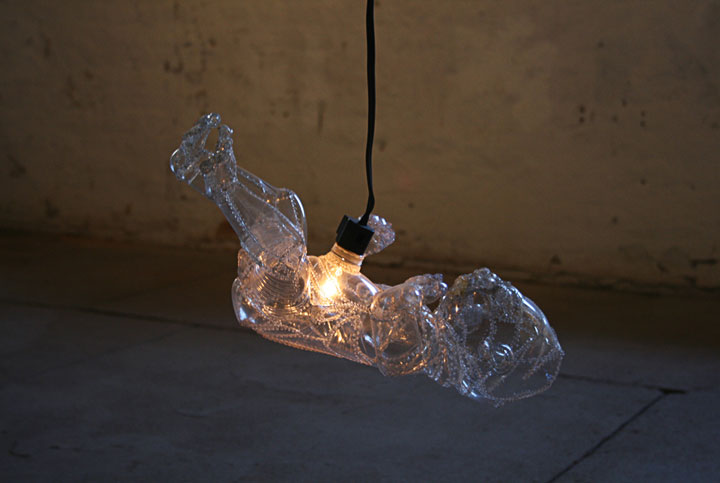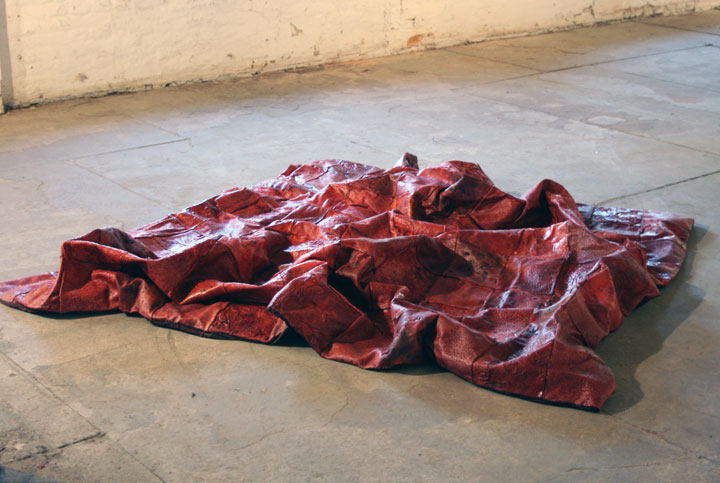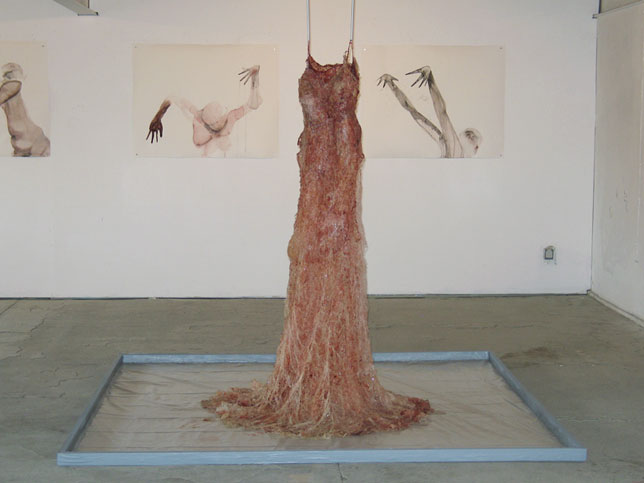THE BLEEDING DRESS
By Verónica Mijelshon
On the occasion of D. Zorreguieta's solo show "The Bleeding Dress" at STYX Projects in Berlin.
Although the dream is a very strange phenomenon and an inexplicable mystery, far more inexplicable is the mystery and aspect our minds confer on certain objects and aspects of life. Psychologically speaking, to discover something mysterious in objects is a symptom of cerebral abnormality related to certain kinds of insanity. I believe, however, that such abnormal moments can be found in everyone, and it is all the more fortunate when they occur in individuals with creative talent or with clairvoyant powers. Art is the fatal net which catches these strange moments on the wing like mysterious butterflies, fleeing the innocence and distraction of common men. —Giorgio de Chirico
Scene: a life size baby with attached umbilical cord lies abandoned, a bleeding dress is suspended from metal cable tensors, a quilt of raw flesh sits nonchalantly on the floor. The objects remain motionless, exuding a highly disturbing message. We wonder if we have entered a slaughterhouse, the scene of some hideous crime. A la Francis Bacon, one of Dolores Zorreguieta’s influences, we get the sense that the worst has happened.
Reaction: At first we are repelled. We want to turn and leave but we find ourselves unable to go … we crave for more. We stand in a mute silence, observing, trying to link the leftovers together, looking for answers; avid voyeurs and also accomplices. While observing we experience some kind of emotional pain, yet we remain there and start asking ourselves if we in fact enjoy this pain.
The space containing this scene has a rawness that matches Zorreguieta’s work, but once we recognize the environment we feel more at ease; the context is permissive and invites us to linger. Yet as we wander the gallery, we begin to question whether we are being deceived by a sense of false comfort.
For Zorreguieta’s objects attract and repel at the same time. Zorreguieta provokes our innocent voyeurism… There is an inexplicable magnetism that occurs when horror merges with beauty. It is this magnetism that seduces us, that keeps us in the gallery, prisoner of our fears.
Although we are in the presence of figurative sculpture, we are not asked here to be mere observers, we are pushed to interpret; Zorreguieta gives us material impregnated with meaning which calls for a second interpretation. That is how the artist delivers, there is no linear reading. The more we connect with her work, the more we are drawn in, and the more we discover. The artist knits together opposites, metaphors and ambiguities. In the realm of these contradictions we wonder where all this violence, aggression, pain, wounds, cries, desperation, isolation and abandonment come from. Are they embedded in the artist’s past, is it autobiographical? Yet on meeting the artist we find a warm, kind, funny woman, with a permanent smile on her face.
Each piece of Zorreguieta’s works reveals these contradictions. Bleeding Dress, the piece that gave name to this exhibition, is a sculpture made of wool fiber, acrylic media, silica, pigments, plastic and glue. From afar, none of the materials are apparent; we see a beautiful evening gown, a floor length bride’s dress or a dress for a special night, with straps, insinuating a sexy cleavage. Layers of mesh-like weave fall graciously to the floor. But as we get closer, the pleasant image we imagined vanishes. Now we see an alveoliform surface tinted with blood bringing to mind Federico Garcia Lorca’s play Bodas de Sangre (Blood Wedding.) Louis Bourgeois is one of Zorreguieta’s influences and her sculptures have been described as revealing a ‘soft violence.” This term seems appropriate for Zorreguieta’s work as well for she consistently creates ambiguity, turning soft and flexible materials into cruel intimidating objects.
Zorreguieta’s work is intensely expressive and rich. She considers herself a spontaneous/natural/innate feminist and feminism is evident in the subjects she brings up and the techniques she uses. While blood is a recurrent element, there is an uncertainty about what kind of blood this is; is it coming from self-inflicted violence, from external violence, from a disease, from menstruation? It seems that at this point in her career, Zorreguieta is less interested in giving the viewer answers than in generating questions.
In a similar manner to a film preview, Zorreguieta’s work anticipates ideas that will be developed in her next series. What is a mere element in one piece later evolves and becomes the main subject in the next piece. Each work is an incubator for the upcoming work. Her subjects and materials mutate into the new idea. It is as if Zorreguieta works in a circle, or better, in an ellipse, the favorite shape of Louise Bourgeois. An ellipse is an ambiguous shape, with two centers, two axes… It has a level of symmetry, and yet it remains a bit unsettling. In her 1997 series La Mujer Saco, (‘The Sac Woman’, not included in this exhibition), a collection of canvas collages each presents its own narrative that includes a photo. When we examine this series, we find the germination of the 2004 piece Fotonovela (Photonovela, not included), where a narrative is created from a group of photos. And in both, we see pain, fear, blood, violence, humor, darkness, impotence.
My Baby Frankenstein is a ‘at-uterus’ height suspended sculpture made of recycled plastic bottles. The baby’s belly is illuminated by a light bulb connected to the power by a long cable that resembles an umbilical cord. The baby is life size, but it seems an absurd, comical ‘object.’ It evokes a feeling of desolation, fragility, impotence, injustice, sadness. Why this baby was abandoned? Was it as a product of some strange, unknown experiment? Plastic bottles are recyclable material; is this a reference to an endless life, to an ever young attitude? Is Zorreguieta referring to Wilde’s Dorian Gray? Or is it a reference to maternity fears, or today’s ability to tailor our babies? With this ‘new life’ we may be in the presence of a new creative path for the artist, and as in the same way as her other works, what we witness is provocative, disturbing, yet strangely attractive.
With Quilt, the viewer is confronted again by the same subjects. Deliberately thrown on the gallery floor, Quilt has a sadistic red color that suggests the color and feel of flesh. It looks like a flat landscape made of chunks of flesh, sewn together, covering secrets. Although domesticity and femininity are intimately associated with the making of quilts, this particular quilt offers none of the expected warmth or protection.
While trying to understand what happened in this gallery, we perceive the presence of few creatures that may offer us some clues. Manos Sucias (‘Dirty Hands’) is a series of marvelously made watercolors hanging from the wall. Each work consists of a single drawing floating on white paper. As we inspect them, they irreverently flaunt their hands at us. The use of watercolors gives Zorreguieta a more liquid language; they look like ameboid, rose-pink stains that converge to shape a human body. Shouting their grim participation in the scene above, these characters seem to feel unimpugnable, as if they can do harm but nothing can harm them. They carry a kind of attitude, of abuse of power reminiscent of political characters who may participated in ‘dirty business.’ Knowing Zorreguieta’s country of origin, our thoughts turn to Argentina’s dictatorship. But with Zorreguieta’s work, there is never merely one interpretation.
In this series, the artist focuses on hands, a body part that was missing in her 1998 series ‘Monstruos’ (‘Monsters, not included’.) ‘Monsters’ are cute yet repulsive characters, horrific, deformed mouths lacking limbs, some individual pieces, other in pairs conjoined by the heads. Yet without any arms, viewers may wonder how much harm these monsters can do; they look repugnant yet inoffensive, and so we start progressively accepting them, even liking them. ‘Manos Sucias’ may be another turning point in the artist’s exploration. Contrary to previous characters which were frightening but probably impotent, these “hands” are able to ‘do’ or ‘communicate’ more actively, and may indicate a new curvature in Zorreguieta’s elliptical journey.
As we depart the gallery, thinking about blood, violence, wounds, pain, metaphors, ambiguity it is amusing to wonder what Sigmund Freud, Bourgeois, Bacon, Kafka would have had to say.
June 2011
Veronica Mijelshon is an independent curator, founder and director of 0.00156 acres. Former Gallery Director of NURTUREart Gallery (2004 – 2007). Born in Buenos Aires, Argentina, she completed her architecture degree at the University of Buenos Aires. Her past curatorial projects include Between To and From (a collaboration with Eleanor Eichenbaum) in the Visual Art Center of New Jersey (2008); it’s a small world, at gallery the, Brooklyn, NY, 2006; please OPEN the door, exploring the private and public subject at the NURTUREart Gallery, Brooklyn, NY, 2004/06; a commission by artist Sharon Louden for Technics, Miami, FL, 2004; Flight, a site-specific installation by artist Lucia Warck Meister, DUMBO, Brooklyn, 2003. Currently she directs 0.00156 and also is the art and architecture consultant for a restaurant company in New York City.
BACK TO TEXTS BY OTHERS
GO TO WORK SECTION
WATCH EXHIBITION VIDEO





